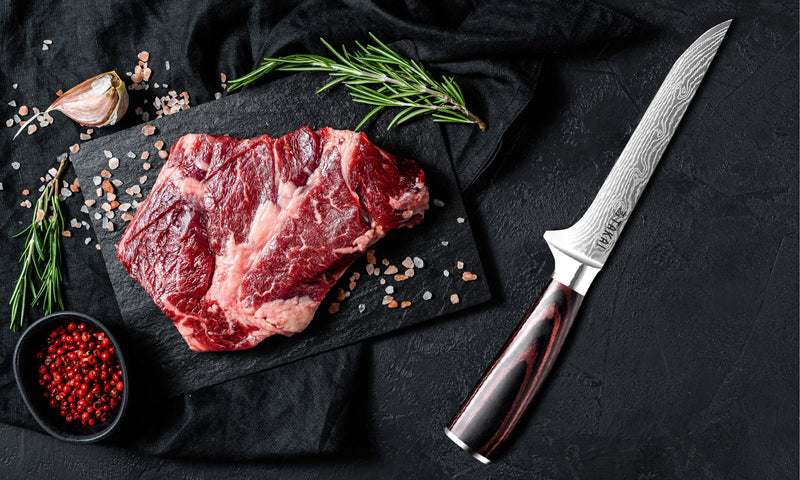The difference between boning knife and filleting knife is a topic that often puzzles both amateur cooks and professional chefs alike. These two knives, while similar in appearance, serve distinct purposes in the kitchen. Understanding their unique features can greatly enhance your culinary skills, whether you’re preparing a gourmet meal or simply cooking at home.
Both knives are essential for any serious kitchen, but knowing when and how to use each one is crucial. In this article, we’ll explore the differences between these two types of knives, their specific uses, and how to choose the right one for your needs.

Understanding the Boning Knife
What is a Boning Knife?
A boning knife is a specialized kitchen tool designed for removing bones from poultry, meat, and fish. It features a narrow, flexible blade that allows for precise cuts and easy maneuvering around bones. This flexibility is what sets it apart from other knives commonly found in the kitchen.
Features of a Boning Knife
- Blade Length: Typically ranges from 5 to 7 inches, making it ideal for detailed work.
- Flexibility: A more flexible blade is better for delicate meats, while a stiffer blade is suited for tougher cuts. Learn more about why a stiff boning knife is better here.
- Handle: Ergonomically designed for a comfortable grip.
Uses of a Boning Knife
The primary use of a boning knife is to separate meat from bones. It’s also excellent for trimming fat and sinew. Whether you’re handling chicken, beef, or pork, a boning knife is indispensable. For example, discover how to debone pork ribs with precision here.
Understanding the Filleting Knife
What is a Filleting Knife?
A filleting knife is designed specifically for filleting fish. It features a long, thin, and flexible blade that allows for smooth, clean cuts. This knife is essential for anyone who frequently prepares fish at home or in a professional setting.
Features of a Filleting Knife
- Blade Length: Generally ranges from 6 to 11 inches.
- Flexibility: The blade is highly flexible to easily glide through fish flesh.
- Handle: Often features a non-slip grip for safety when working with slippery fish.
Uses of a Filleting Knife
Filleting knives excel at removing skin and bones from fish, creating perfect fillets with minimal waste. These knives are also suitable for slicing other delicate proteins.
Key Differences Between Boning and Filleting Knives
Blade Design
The most noticeable difference between boning knife and filleting knife is the design of the blade. Boning knives have a thicker, less flexible blade, while filleting knives are thinner and more flexible.
Purpose and Use
While both knives are used to separate meat from bones, a boning knife is more versatile, handling a variety of meats. A filleting knife is specialized for fish, offering precision and ease in creating fillets.
Material and Construction
Both knives are typically made from high-quality stainless steel, but the filleting knife often has a finer edge suited for delicate tasks.
Choosing the Right Knife for Your Needs
Consider the Type of Meat
If you frequently prepare fish, a filleting knife is a must-have. For those who handle a variety of meats, a boning knife offers more versatility.
Assess the Flexibility Requirement
Consider the flexibility you need based on the type of meat you cook. A more flexible blade is better for intricate work.
Evaluate the Handle Comfort
Choose a knife with an ergonomic handle that feels comfortable during use.
Maintaining Your Knives
Proper Care and Cleaning
Always hand wash your knives and dry them immediately to prevent rust and maintain sharpness.
Sharpening Techniques
Regularly sharpen your knives using a whetstone or professional sharpening service to ensure optimal performance.
Storage Tips
Store your knives in a protective sleeve or on a magnetic knife strip to avoid dulling and damage.
Conclusion
Understanding the difference between boning knife and filleting knife can significantly improve your kitchen efficiency and effectiveness. Each knife has its own unique advantages and is suited to specific tasks. By selecting the right knife and maintaining it properly, you can enhance your culinary skills and enjoy the art of cooking even more.

FAQ Section
What is the main use of a boning knife?
A boning knife is primarily used for removing bones from meat, such as chicken, beef, or pork. It is also useful for trimming fat and sinew.
Can a filleting knife be used for meat other than fish?
While a filleting knife is designed for fish, it can be used for other delicate proteins where precision is required.
How often should I sharpen my boning and filleting knives?
It’s recommended to sharpen your knives regularly, depending on use. For frequent users, once a month is advisable.
For more information on boning knives, check out this external guide.
This article contains affiliate links. We may earn a commission at no extra cost to you.


